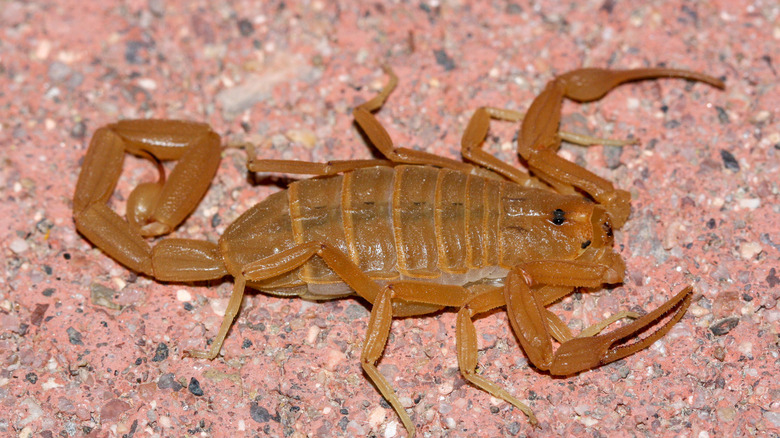If This Dangerous Texas Animal Stings You On Your Face, Your Odds Aren't Good
The Arizona bark scorpion (Centruroides sculpturatus) may be small — typically ranging in size from 1 to 3 inches long — but don't let its size fool you. This desert dweller is the most venomous scorpion in North America, and its sting can be especially dangerous when delivered to sensitive areas like the face. (Here's how to tell if a spider bite is venomous.)
Arizona bark scorpions are tan in color, which helps camouflage them when they are against tree bark or rocky surfaces. They additionally have long, thin pincers that are lighter colored than their bodies. Their tails are also long and slender, with a stinger on their tip. They are nocturnal and tend to remain hidden under rocks or logs during the day. However, they are also good climbers, so you may find them in higher locations such as walls or trees. They are most active from spring through fall.
While it's named after Arizona, this scorpion also lives in parts of New Mexico, California, Nevada, Utah, and yes, Texas, where unsuspecting residents can encounter it in their homes, shoes, or even bedding. If you're living in or visiting Texas, knowing how to identify, avoid, and respond to an Arizona bark scorpion sting could make all the difference.
What's it like to be stung by the Arizona bark scorpion
According to Rare Disease Therapeutics, Inc., the U.S. distributor of Anascorp, an antivenom used to treat Arizona bark scorpion stings, if you are stung by the animal, you will immediately feel burning and stinging at the site. The pain of a sting can be intense, with some likening the feeling to an electric shock.
These sensations may then be followed by impaired muscle coordination, unusual eye movements, problems speaking, breathing difficulties (here's what to do if you have trouble breathing), drooling, foaming at the mouth, nausea, and vomiting, according to Rare Disease Therapeutics, Inc. A sting to the face can be particularly problematic since it can lead to blockage of the person's airway. Symptoms can last for up to three days.
Arizona bark scorpion stings are rarely fatal, but they can be especially dangerous for young children, older adults, and individuals with compromised immune systems. Rare Disease Therapeutics, Inc. notes that most stings occur in children. Out of 1,534 patients in clinical trials, 78% were reported to be children, per a 2012 review in The Journal of Pediatric Pharmacology and Therapeutics.
How an Arizona bark scorpion bite is treated
You can call Poison Control at 1-800-222-1222 if you are ever stung by an Arizona bark scorpion. They can assist you with first aid and help monitor your condition.
Preventative Pest Control additionally notes that visiting a hospital and receiving an FDA-approved antivenom can help reduce the intensity of your symptoms. They also advise cleaning the area of the sting with soap and water and placing a cold cloth or ice pack on it. You can also take acetaminophen (Tylenol) to help reduce swelling. (This is how long it takes Tylenol to start working.)
To prevent getting stung in the first place, it's wiseto hire a professional scorpion extermination service. Other best practices include moving cribs and beds away from walls; checking any linens, towels, shoes, or clothing before use; placing crib legs in glass jars so scorpions can't climb up; and being aware of any damp towels or laundry since scorpions are attracted to moisture.


